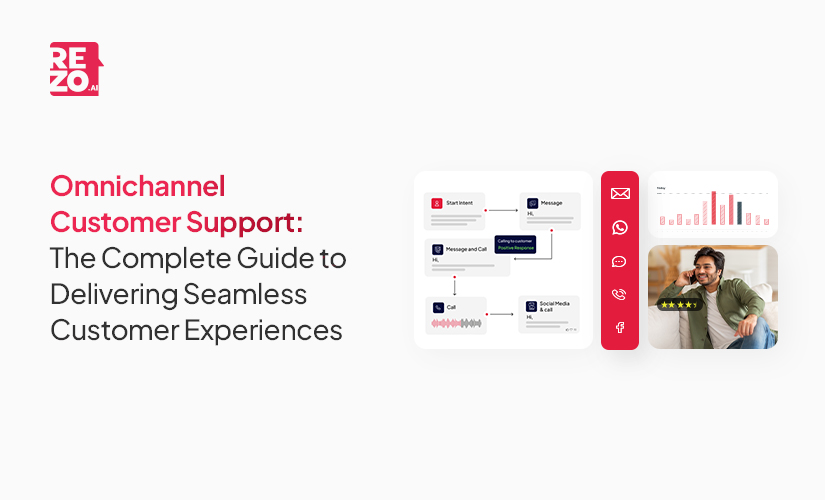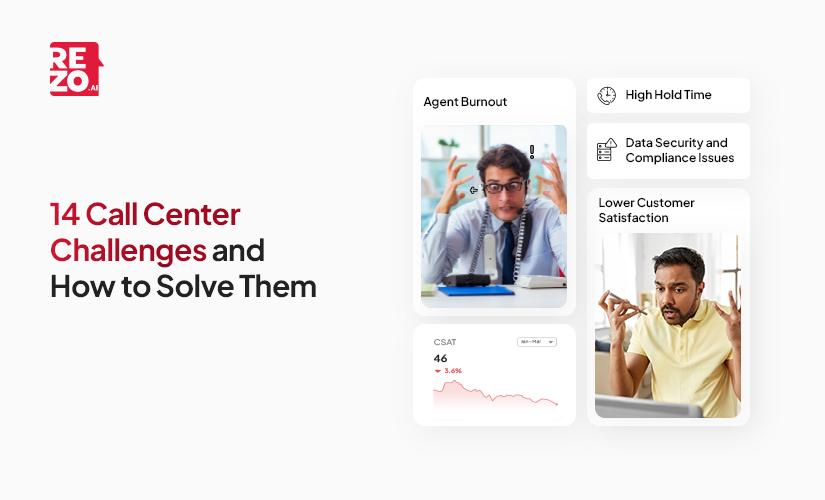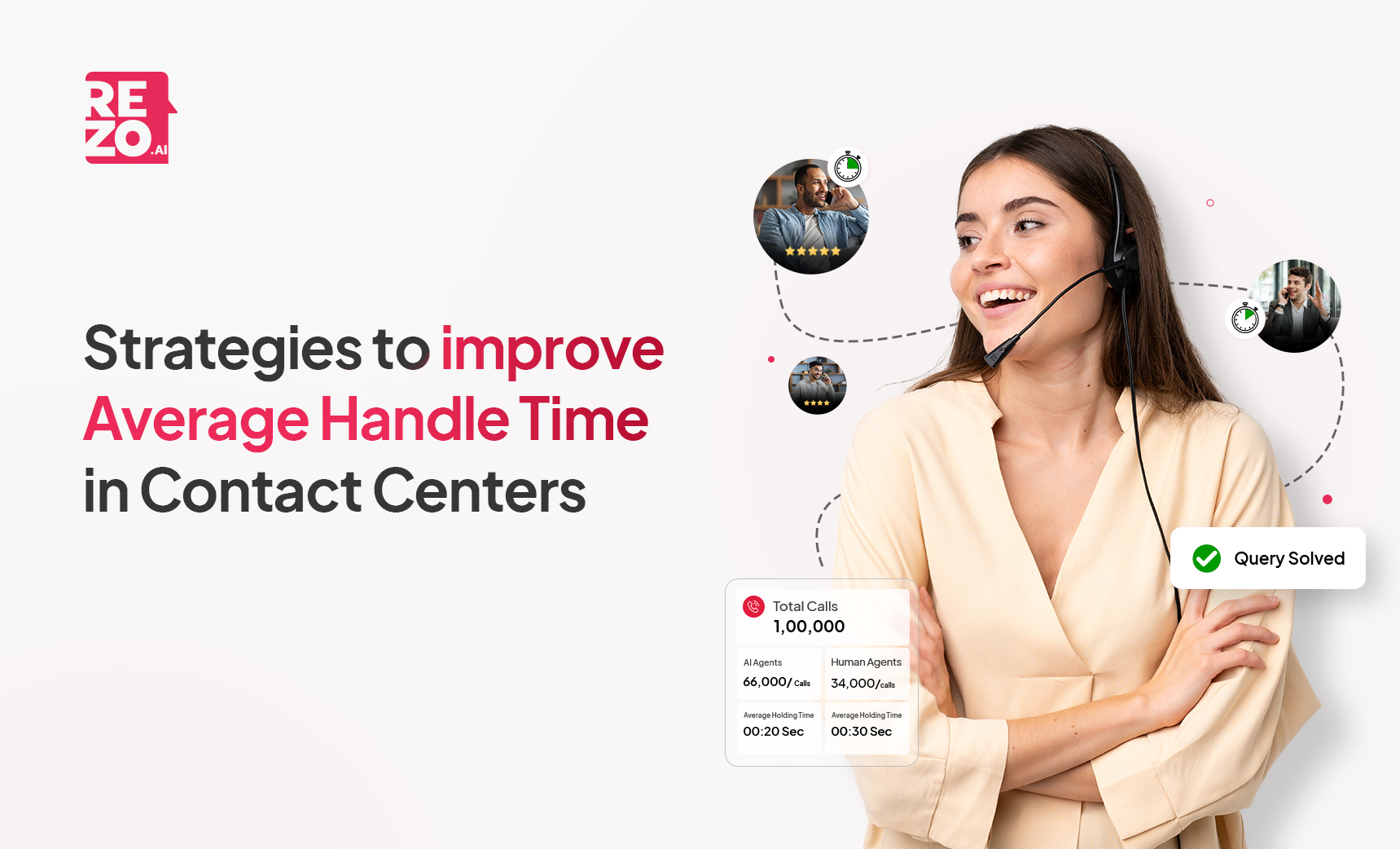
10 Strategies to improve Average Handle Time (AHT) in Contact Centers
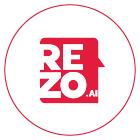
10 Strategies to improve Average Handle Time (AHT) in Contact Centers


In the contact center industry, every second matters, making Average Handling Time (AHT) one of the most critical metrics for measuring operational efficiency. As a cornerstone performance indicator, AHT reflects how quickly agents resolve customer inquiries and directly impacts resource allocation, cost management, and overall service delivery.
However, reducing AHT should never compromise service quality. Rushed interactions and inadequately resolved issues lead to customer dissatisfaction and negatively affect Net Promoter Scores (NPS), ultimately harming long-term customer relationships. Contact centers must therefore adopt strategic approaches that optimize AHT while maintaining exceptional customer experience and sustaining overall operational performance.
Ready to find out how? Let’s dive in
What is Average Handle Time?
According to a Forbes study, the more time customers spend resolving a query, the less likely they are to be satisfied with the service, as today's consumers prefer instantaneous responses over calls with higher talk times.
Average Handle Time (AHT) is an important metric in contact centers that measures the average time a call center agent takes to complete a customer interaction from start to finish. It provides a clear picture of how efficiently support agents handle customer issues.
The Three Components of AHT:
- Talk Time: The actual time spent speaking with the customer.
- Hold Time: The time customer waits while the agent retrieves information or escalates the query.
- After-Call Work Time: The time spent by the call center agent completing tasks after the call, like updating records, documenting details etc.
By tracking AHT, contact centers can identify areas for improvement such as poorly trained agents, outdated knowledge bases, or ineffective call routing.
Why Measuring Average Handling Time is important for Contact Centers?
Tracking Average Handle Time (AHT) is a crucial strategy for contact centers aiming to enhance both operational efficiency and customer satisfaction. By analyzing this AHT metric, contact centers can uncover actionable insights that lead to optimized processes, better experiences, and reduced costs.
Here’s how measuring and optimizing AHT benefits your business:
Identify Operational Bottlenecks
AHT metric helps you find inefficient processes such as redundant tasks, system lags, or training gaps that silently increase call durations and thus affect the bottom line of a contact center.
Boost CSAT Score
Measuring AHT encourages contact center agents to resolve customer issues as quickly as possible, minimizing call holding time.
Quicker handling of customer queries ensures a smoother experience, directly boosting CSAT by making interactions more efficient and less frustrating for customers.
Identify Areas for Product Improvement
AHT analysis can help you identify product-related issues, such as confusing features that extend call times. This enables targeted product updates and better self-service options.
Maximizing Profit through efficient tracking
Tracking AHT allows you to pinpoint inefficiencies and identify areas where excessive time is being spent and areas that can be automated with AI-driven assistants. Ultimately reducing costs and enhancing overall efficiency.
How to calculate Average Handle Time?
.webp)
The calculation of Average Handle Time (AHT) varies according to the communication channel you’re using.
To help you analyze efficiency accurately in this omnichannel environment, below are the Average Handling Time formulae for three important customer service channels:
For instance, consider two companies:

AHT = (Total Talk Time + Hold Time + Post-Call Work)/ Total Number of Calls
Company A, with 20,000 minutes of talk time, hold time, and after-call work time spread across 4,500 calls, achieves an AHT of 4.4 minutes.
In contrast, Company B, with 17,000 minutes over 2,500 calls, has an AHT of 6.8 minutes.
Despite fewer calls, Company B spends significantly more time per interaction, pointing potential inefficiencies that could lead to higher costs, longer holding times, and low satisfaction.
Limitations of the Average Handle Time
While Average Handling Time is a useful metric for measuring contact center efficiency, it has limitations. Focusing solely on this metric can lead to:
1. Neglecting Customer Experience:
AHT doesn't directly measure customer satisfaction. Prioritizing speed over quality can lead to rushed interactions, unresolved issues, and lower customer satisfaction.
2. Ignoring Complexity:
AHT doesn't account for the complexity of customer queries. Penalizing agents for taking longer on complex issues can demotivate agents and negatively impact customer experience.
3. Misaligned Incentives:
Focusing solely on AHT can create a culture where agents prioritize speed over accuracy and customer satisfaction, leading to suboptimal outcomes.
Rather than focusing solely on Average Handling Time, it’s essential to align this metric with goals that prioritize customer satisfaction and issue resolution. Let’s explore how to use handling time alongside other key metrics to achieve both efficiency and exceptional service quality.
The Right Way to Approach Average Handling Time Optimization
Although Average Handle Time has its limitations, it remains a valuable tool when utilized strategically in conjunction with other metrics.
When applied correctly, AHT can provide actionable insights to improve operational efficiency without compromising the customer experience.
Here’s how you can make the most out of average handling time and meet contact center kpis:
- Customer Satisfaction (CSAT): Use CSAT surveys to measure the quality of customer interactions alongside handling time. A low handling time with high CSAT indicates efficient and effective service, while low CSAT may highlight rushed or incomplete resolutions.
- First-Call Resolution (FCR): Track how often issues are resolved on the first interaction. A low handling time with poor FCR suggests speed is prioritized over resolution, which can frustrate customers and increase repeat calls.
- Net Promoter Score (NPS): This metric gauges customer loyalty. A balanced average handling time combined with a high NPS reflects a positive customer experience.
By combining AHT with these metrics, you gain a comprehensive view of performance. This enables you to optimize contact center agents' efficiency, provide agents training where necessary, and improve customer satisfaction, ensuring a well-rounded, effective approach to contact center management.
What’s a good average handling time for Contact Centers?
While the widely accepted industry benchmark for Average Handling Time is approximately six minutes, this standard is inherently dynamic and varies considerably across different contexts. The fundamental principle to remember is that AHT serves as a tool to enhance efficiency, but should not provide a compromised quality service.
According to data from Global Contact Center KPI Benchmarking Report, Average Handle Time varies significantly across industries due to factors like CX strategy, support channels, product or service complexity, and team structure. What constitutes an optimal AHT for your business depends on these unique variables.
Here’s the industry breakdown for Average Handling Time:
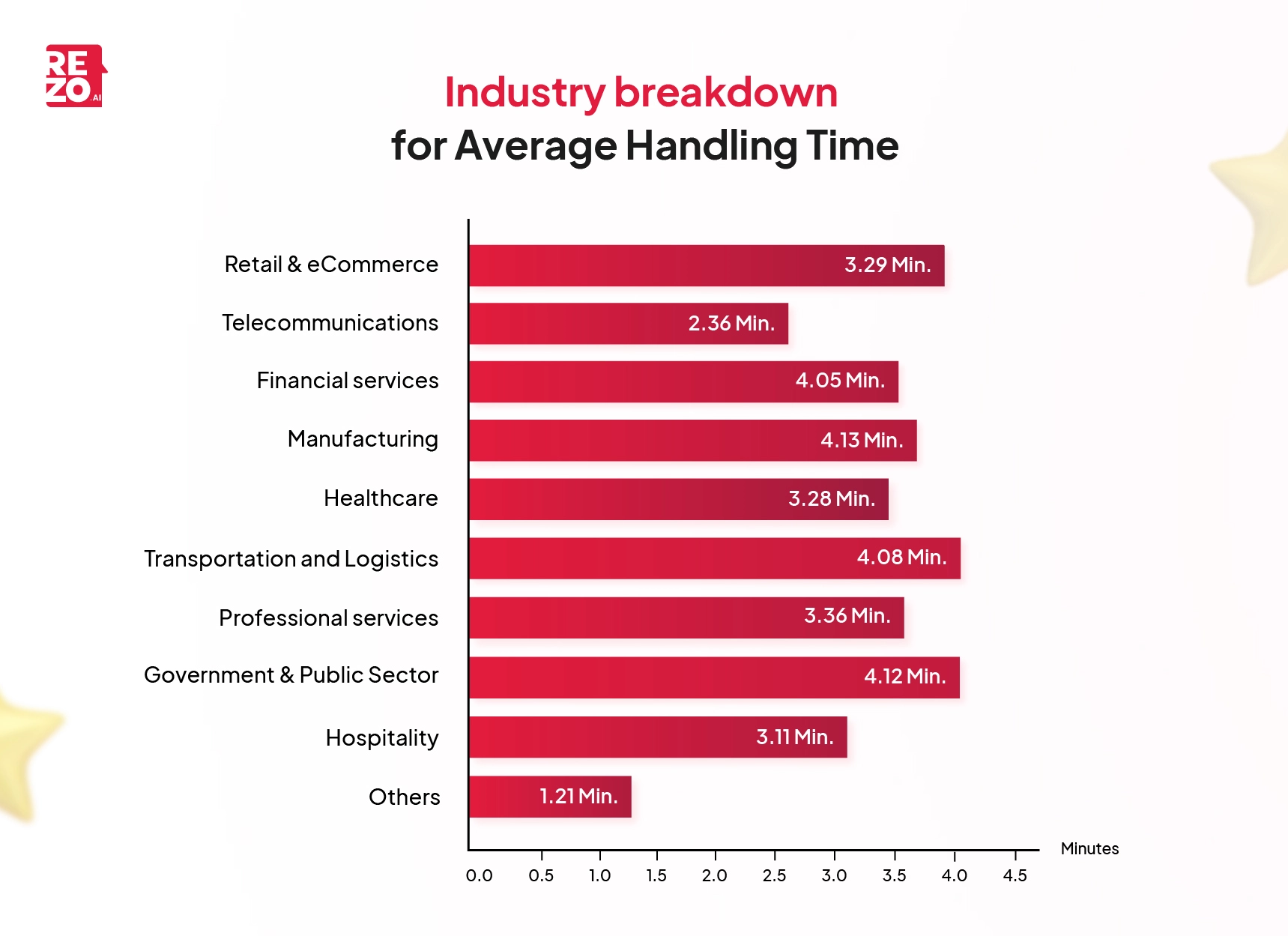
10 Key Tips to Improve Average Handling Time (AHT)
Reducing Average Handling Time is a critical goal for call centers as it a key performance indicator in enhancing customer satisfaction. By implementing the right strategies, businesses can streamline operations, minimize delays, and deliver quicker resolutions.
Here are 10 key strategies to effectively reduce AHT and improve call center AHT performance:
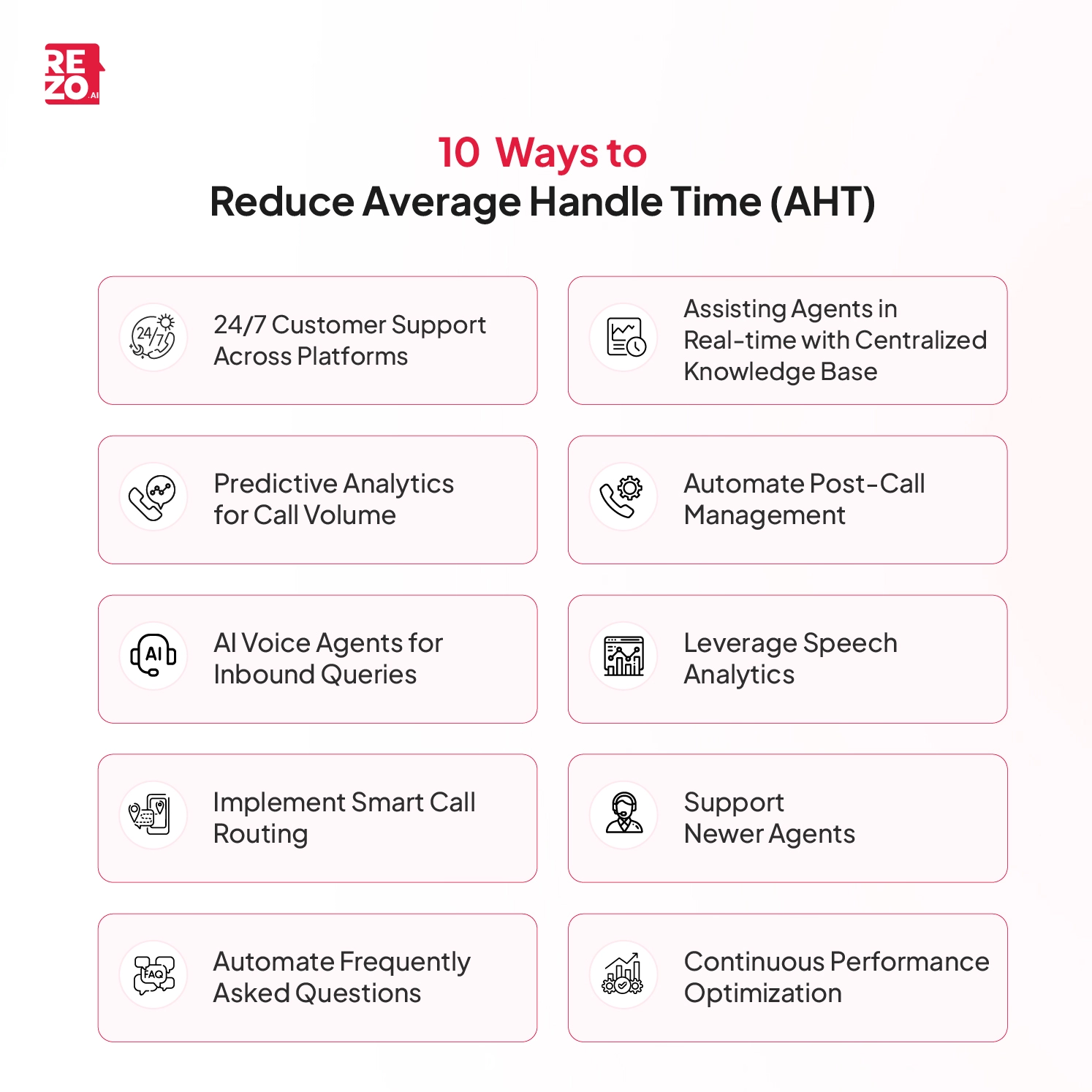
1. 24/7 Customer Support Across Platforms
Conversational AI enabled round-the-clock support across voice, chat, email, and social media, providing instant assistance to customers anytime. This reduces wait times, improving efficiency, and lowering down Average Handling Time by automating routine queries, allowing agents to concentrate on more complex queries.
2. Assisting Agents in Real-time with centralized knowledge Base
AI helps agents to analyze customer conversations in real time, instantly providing prompts with the best possible responses. This enables agents to address queries quickly without placing customers on hold, reducing handling time and enhancing overall efficiency.
3. Predictive Analytics for Call Volume
Use Predictive Analytics AI tools to predict peak call times and adjust staffing accordingly, ensuring that agents are not overburdened, which can lead to longer handling times due to stress or lack of resources.
4. Support Newer Agents
Newer agents often have a higher AHT, as they are still learning to solve queries. By setting up an AHT Glidepath, call centers can track the improvement agents make in reducing handling time. AI tools can be implemented to support newer agents, such as Rezo AI's real-time agent assist, which provides a comprehensive knowledge base with previous recorded call data, customer intent, and other information that helps agents resolve queries more efficiently.
5. Automate Post-Call Management
Post-call summaries, collecting customer feedbacks and follow-up tasks can be automated with Rezo.ai. This reduces manual note-taking and administrative time, allowing agents to focus on more valuable interactions, ultimately improving efficiency, reducing operational costs and providing satisfied customers.
6. AI Voice Agents for Inbound queries
Deploy AI Voice Agents to handle routine queries with multi-lingual responses, allowing queries to be resolved on the first contact. This not only reduces AHT but also eliminates unnecessary escalations to agents, enabling them to focus on higher-value tasks.
7. Leverage Speech Analytics
Speech analytics empowers contact centers by analyzing customer-agent conversations post-call to extract valuable insights and identify trends, sentiments, and customer intent. This data helps streamline responses for future calls, enabling support agents to resolve queries faster and provides lower AHT.
8. Implement Smart Call Routing
Using an AI assistant to identify the critical customers query and route these customer calls directly to the right department. This reduces unnecessary bouncing and connects customers to the right expert from the start, minimizing delays, improving efficiency, providing a lower aht, optimized talk time and better customer experience.
9. Automate Frequently Asked Questions
Use Agentic AI agents to resolve customer queries, providing customers with self-service resources and solutions for repeated queries, shortening average talk time and improving AHT.
10. Continuous Performance Optimization
Perform quality assurance on existing calls handled, monitor AHT data, and track average handle time to identify areas where call center managers need to focus to improve overall efficiency. Automated QA tools can deliver these analytics by evaluating 100% of customer interactions with AI-driven scoring and sentiment analysis, helping identify trends in performance and compliance. These tools provide actionable insights, highlighting which agents need comprehensive training, which processes can be automated, and how to reduce the average length of calls to enhance both operational performance and customer satisfaction
Here’s How we reduced Average Handling Time for a Retail Giant: LivGuard
Livguard, a leading energy solutions provider, was facing high operational costs and high Average Handle Time in their contact center. We managed to make operations more efficient at the Livguard contact center by integrating AI-powered Virtual Assistants. This resulted in 38% Average Handling Time reduction for their contact centers.
Key Steps Taken to reduce average handle time:
1. Automation of Routine Inquiries:
Rezo.ai automated 66% of customer engagements which include complaints, requests for product information, and inquiries on status updates. This will lead to faster responses to customers while reducing the average handling time by 38% and improving overall contact center performance.
2. Increased Call Volume with AI Automation:
By leveraging AI automation, the contact center significantly boosted its call-handling capacity, managing 73% more calls than before. This improvement not only reduced customer holding period but also ensured quicker query resolutions, enhancing overall operational efficiency.
3. 24/7 AI Support:
With AI managing inbound queries 24/7, we helped Livguard ensure customers received immediate assistance at any time, reducing wait times and preventing delays. This round-the-clock support helped streamline operations and significantly lowering average handling time.
4. Identifying Upsell Opportunities:
Automating common inquiries enabled AI agents to detect upsell opportunities during interaction. For example, when customers contact for help with existing product, agents had simply offered associated services such as preventative maintenance plans or AMC (Annual Maintenance Contract) renewals, further increasing revenue.
By reducing AHT, Livguard was able to improve overall contact center efficiency, lower operational costs, and increase customer satisfaction, delivering quicker responses and resolutions without compromising on service quality.

Enhance your Average Handling Time effortlessly with Rezo.ai
In conclusion, optimizing Average Handle Time or AHT is more than just a metric, it's a powerful lever to enhance your customer journey, reduce call center costs, and improve customer satisfaction score.
The key lies in implementing the right strategies to balance speed and service quality, ensuring your team is equipped to handle customer interactions swiftly focusing on customer sentiments without hurrying customers or sacrificing the personal touch.
At Rezo, we help contact centers achieve this balance with our AI-powered solutions, specially designed to reduce AHT while maintaining personalized service. Our smart routing, AI voice bots, and real-time agent assistance ensure that your team works efficiently, handling more customer interactions with greater accuracy and speed.
Ready to transform your contact center and reduce AHT without compromising service quality?
Book a free consultation with our AI experts today and discover how Rezo.ai can help you unlock significant improvements in performance, efficiency, and customer satisfaction.
FAQ:
How to calculate Average Handling Time for chat?
The formula for calculating AHT for chat is:
AHT = (Total Chat Duration + Total Hold Time + Total After-Chat Work Time) ÷ Total Number of Chats
This helps measure efficiency across chat interactions.
Refer to the formulas above for a detailed guide on calculating handling time across channels.
How to reduce Average Handling Time in BPO?
To reduce Average Handling Time or AHT in BPOs, leverage automation, AI-powered tools, and speech analytics. Automating routine tasks, providing real-time agent assistance, and analyzing post-call data can streamline processes, improve efficiency, and help agents resolve customer queries faster, ultimately reducing handling time.
What is a good Average Handling Time?
A good Average Handling Time is typically estimated at around 6 minutes, however it can vary depending on the industry and query complexity. While shorter AHT is desirable, it should not compromise service quality and maintain customer expectations.
How to improve AHT as an agent?
An improved AHT reflects an agent's performance. To achieve lower AHT and to reduce after call work, agents should focus on first contact resolution.
Do remote workforces have a higher AHT?
Remote workforces may experience slightly higher AHT due to factors like limited access to on-site resources, slower system connectivity, or reduced collaboration opportunities.
However, with proper tools like AI-driven agent assist, centralized knowledge bases, and real-time support, these challenges can be mitigated, ensuring remote teams maintain or even improve AHT performance.
Frequently Asked Questions (FAQs)

Take the leap towards innovation with Rezo.ai
Get started now







